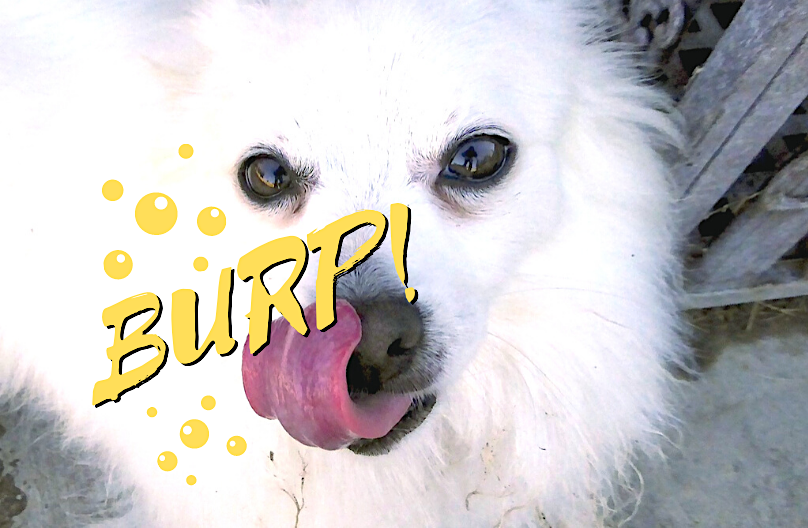
Does your dog eructate gas through their esophageal sphincter?
Wait. Huh?
The answer (even if the question made no sense) is yes, because this is exactly what happens when a dog burps. A burp is the passage of air from the stomach, up the gullet and out of the mouth — sometimes accompanied by a little pop of wind.
Call it burping, belching or eructation … many mammals do it, including humans and our canine companions. Indeed, it’s my dog Pogs’ party piece because when she burps, her jowls flutter endearingly, which is incredibly sweet (to me, at least).
As a veterinarian, I find it reassuring when Pogs burps, because it means air can escape from her stomach.
When a dog is unable to burp because their stomach is sealed off, this is potentially very serious and a sign of an emergency condition known as bloat.

Why Do Dogs Burp?
When a dog eats, part of the digestive process involves producing gas, a bit like a car engine produces exhaust.
Those gases have to go somewhere — otherwise, the dog would inflate like a giant balloon.
The healthy way for a body to get rid of gas is to pass it forward as a burp or backward as flatulence. Both are normal and healthy in moderation.
The amount of gas the dog vents is influenced by several things. Of these, the most common causes of excessive gas are the ingredients in the dog’s food and how quickly the dog eats.
Fermentable Foods
There’s a reason baked beans are the butt (see what I did there?) of jokes. Beans are highly fermentable, which means they produce lots of gas, which is released as flatus.
The same goes for some dog foods. Some ingredients are notorious for producing gas in the gut. Topping the list of stomach churners are eggs, cruciferous vegetables (such as cabbage and Brussels sprouts), beans and cheeses.
Gulping Down Gas
My dog’s favored eating technique is not to chew but to swallow food whole as fast as she can.
The downside of this? She swallows a lot of air. If your dog takes this vacuum cleaner approach to food, chances are they swallow a lot of air.
That swallowed air is the doggy equivalent of a shaken bottle of lemonade, and it needs to escape somehow. The path of least resistance is for the dog to burp it out.
Brachycephalic Burps
On a theme, brachycephalic breeds such as Pugs, Bulldogs and Frenchies tend to pant a lot. Panting is also associated with sucking air down into the stomach, which may come back up as burps.
Upset Stomach
Sometimes burping can be a clue the dog isn’t feeling well.
A stomach upset caused by a sudden change of food, inflammatory bowel disease or germs (bacteria, viruses, parasites) is often linked to an increase in gas production. So even though dog burping is natural and healthy, it could also be a sign of ill health.
As a rule of thumb, if the dog has a good appetite, their poop is normal and they seem happy, the occasional burp is nothing to worry about. However, if the dog burps more than usual, seems unwell or has an upset tummy, take note and visit the vet if you’re worried.
Was YOUR Pet Food Recalled?
Check Now: Blue Buffalo • Science Diet • Purina • Wellness • 4health • Canine Carry Outs • Friskies • Taste of the Wild • See 200+ more brands…

Is Burping Bad for Dogs?
No. To put it simply, a reasonable amount of burping by a dog is entirely normal and a good thing.
Excessive Burping: Why Does My Dog Burp So Much?
Any change from normal behavior (whether it’s thirst, appetite or activity) may be a clue there’s a problem. The same is true for dog burping.
An increase in burping may be a sign the dog is unwell. Monitor the dog closely and look for further clues.
For example, check their poop (do they have diarrhea?), watch for vomiting and keep an eye on appetite. If they do need to see the vet, all of this information will be extremely helpful.
An Inability to Burp
More serious still is when the dog is not able to burp. That gas has to go somewhere — if it can’t escape, the stomach blows up like a balloon. This condition is known as bloat, and it is potentially very serious.
Signs of bloat in a dog include:
- The dog retches but is not able to bring anything up
- Restlessness and distress
- Not able to swallow, which means the dog drools heavily
- A distended or bloated belly
- Collapse
Some of the symptoms can be subtle, so if you have any concerns, call the vet for advice. Bloat requires prompt treatment, and even then it can have serious consequences.
The physical cause of bloat is the stomach flipping over on itself, sealing off the valves at the entrance and exit. This can happen for a variety of reasons. A common reason is exercising on a full stomach, so always leave at least 1 hour between eating and exercise.
What You Can Do If Your Dog Burps a Lot
While a dog burping is not necessarily a problem, it could be a sign that:
- They are eating too quickly.
- Their food isn’t great quality.
- They are swallowing a lot of air because of breathing difficulties.
Generally speaking, a belly full of gas can predispose a dog to bloat, which is something we want to avoid. So for the overly belchy dog, what can you do?

Greedy Eater? Slow Feeders Are the Answer.
There’s plenty you can do to encourage a dog to eat more slowly.
For starters, there’s the cunning use of puzzle feeders or slow feeders. These are self-explanatory and involve the dog having to solve a problem to get to the food, or else the device makes it physically impossible to glug to chow the food down in one scoff.
For Pogs, I use the excellent KONG toy. I pack the KONG in layers of dry kibble, alternating with wet food. She has to lick away at a wet layer in order to release the biscuit, and then repeat the whole thing over again with the next part of the “sandwich.” It slows her mealtime from the blink of an eye to at least 20 seconds.
Lots of other options are out there, and it’s not hard to improvise a slow feeder using things you already have around the house.
For example:
- A muffin tin with small amounts of food placed in each cup depression. This prevents the dog from snaffling everything in one go.
- For smaller dogs who are kibble-fed, use a clean plastic bottle and drill some holes in the side (try to smooth the edges so the dog doesn’t cut their tongue). Put the kibble inside the bottle. The dog then has to bat the bottle around and get the kibble to fall out of the holes.
- Or sprinkle kibble in the grass outside and let the dog root for it.
Avoid Competition at Mealtimes
Some dogs eat fast in order to stop another pet from getting their food.
If this is your dog’s case, consider feeding the dogs in separate rooms. Policing mealtimes with dogs in the same room can help a little, but when they can see each other there’s still pressure to eat quickly to protect resources.
Don’t Feed an Out-of-Breath Dog
It’s safest to exercise your dog on an empty stomach. However, if they come home hot and out of breath and are then fed immediately, this can be troublesome.
Let your pup at least catch their breath before a meal. A dog who is still panting after heavy exercise is going to swallow a lot of air as they eat, so wait a few minutes before feeding.
Food Matters
The food that goes into the dog’s mouth also feeds those gas-producing gut bacteria. The trick to reduce burps and flatulence is to feed a high-quality dog food that’s low in fermentable carbohydrate and proteins.
This means choosing a food that contains named meats among the top few ingredients, rather than soy, cereal, or cheap meat or fish meal.
If you do decide to change the dog’s diet, do so slowly. Take several days to add progressively bigger amounts of the new diet while decreasing the old.
This slow transition is needed to allow the dog’s gut bacteria to adjust. Take things too quickly and the dog may not be able to fully digest the new diet, which is a common cause of diarrhea.
Trivia Questions About Dog Burps and Farts
Amaze and amuse your friends with this gas-related trivia:
- Swallowed air, like what happens when a dog eats too quickly, takes 2 hours to travel the length of the gut and pass out as room-clearing flatus.
- Soybean meal is a cheap protein commonly used to bulk up dog food. However, it’s like rocket fuel for colonic bacteria, which produce lots of noxious-smelling gas that is passed as offensive smelling flatus.
Final Thoughts on Dog Burping
Does your dog burp? Of course they do. And now you know why!
It’s perfectly normal to burp. Just watch out for other signs of ill health, and please see the vet if you feel your dog’s burping has become excessive.
References
- Downing, Robin, DVM, DAAPM, DACVSMR, CVPP. “Dogs and Gas.” VCA Hospitals. https://vcahospitals.com/know-your-pet/dogs-and-gas.
- Kane, Ed, PhD. “Flatulence in Dogs: Annoyance or Sign of GI Illness?” dvm360. Jan. 1, 2015. https://www.dvm360.com/view/flatulence-dogs-annoyance-or-sign-gi-illness.
- Brooks, Wendy, DVM, DABVP. “Bloat: The Mother of All Emergencies.” Veterinary Partner. Aug. 23, 2019. https://veterinarypartner.vin.com/default.aspx?pid=19239&catId=102899&id=4951541.
- Finch, Graham, BVSc, Cert.VD, MRCVS. “Is It Normal for a Dog to Burp So Much?” Dogs Monthly. Feb. 26, 2019. https://dogsmonthly.co.uk/2019/02/26/is-it-normal-for-a-dog-to-burp-so-much/.
- “Flatulence: Farting and Gas Problems in Dogs.” Vetwest Animal Hospitals. https://www.vetwest.com.au/pet-library/flatulence-farting-and-gas-problems-in-dogs.
 This pet health content was written by a veterinarian, Dr. Pippa Elliott, BVMS, MRCVS. It was last reviewed July 15, 2020.
This pet health content was written by a veterinarian, Dr. Pippa Elliott, BVMS, MRCVS. It was last reviewed July 15, 2020. 

